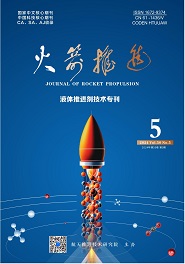航天推进技术研究院主办
LI Chenxi,LI Quan,HUANG Yongzhong,et al.Analysis for multi-physics coupling performance of prismatic dispersed microencapsulated fuel[J].Journal of Rocket Propulsion,2024,50(04):110-116.[doi:10.3969/j.issn.1672-9374.2024.04.011]
多孔弥散微封装燃料元件多场耦合性能分析
- Title:
- Analysis for multi-physics coupling performance of prismatic dispersed microencapsulated fuel
- 文章编号:
- 1672-9374(2024)04-0110-07
- 分类号:
- TL35
- 文献标志码:
- A
- 摘要:
- 高温气冷堆是核热推进的主力候选堆型之一,燃料元件的性能直接决定了反应堆的性能,高温气冷堆的燃料元件形式众多,高安全性的弥散微封装燃料在高温气冷堆中具有极高的应用前景。因此,有必要针对高温气冷堆用弥散微封装燃料开展研究。提出将TRISO燃料颗粒弥散于SiC基体的多孔弥散微封装燃料的设计方案,并基于有限元分析软件COMSOL建立了三维热流固耦合分析模型,初步实现了该燃料元件性能分析,开展了不同冷却剂流量下的燃料元件热力行为分析。结果表明:流量越高,燃料元件最高温度越低,分别为1 340、1 250、1 180 K,远低于SiC材料熔点,无熔化风险; 六棱柱内部的温度分布相对均匀,而六棱柱6个角处的温度分布相对不均匀; 基体最大主应力出现在冷却剂流道周围,最大主应力最大值为95.6 MPa,其余位置整体最大主应力较小,最大主应力低于SiC材料断裂强度。
- Abstract:
- High-temperature gas-cooled reactors are one of the main candidate reactors for nuclear thermal propulsion. The performance of the reactor is mainly influenced by the performance of the fuel element. There are many forms of fuel elements in high-temperature gas-cooled reactors, and high safety dispersed microencapsulated fuels have extremely high application prospects in high-temperature gas-cooled reactors. Therefore, the analysis for microencapsulated fuels for high-temperature gas-cooled reactors is needed. A prismatic dispersed microencapsulated fuel with TRISO particles dispersed in SiC matric was proposed in this paper. Based on the finite element analysis software COMSOL, a three-dimensional thermal-fluid-solid coupling analysis model was established to initially realize the performance analysis of the fuel element and carry out experiments under different coolant flow flux. The results show that the higher the flow rate, the lower the maximum temperature of the fuel element, which is 1 340 K, 1 250 K and 1 180 K respectively. The temperature is far lower than the melting point of SiC material and there is no risk of melting; the temperature distribution inside the hexagonal prism is relatively uniform, while the temperature distribution at the six corners of the hexagonal prism is relatively uneven. The maximum principal stress of the matrix appears around the coolant flow channel, with a maximum value of 95.6 MPa. The overall maximum principal stress at other locations is smaller, and the maximum principal stress is lower than the fracture strength of the SiC material.
参考文献/References:
[1] MILLER G K, PETTI D A, VARACALLE D J, et al. Statistical approach and benchmarking for modeling of multi-dimensional behavior in TRISO-coated fuel particles[J]. Journal of Nuclear Materials, 2003, 317(1): 69-82.
[2]SEN R S, POPE M A, OUGOUAG A M, et al. Assessment of possible cycle lengths for fully encapsulated microstructure fueled light water reactor concepts[J]. Nuclear Engineering and Design, 2013, 255: 310-320.
[3]KING J C, EL-GENK M S. Submersion-subcritical safe space(S4)reactor[J]. Nuclear Engineering and Design, 2006, 236(17): 1759-1777.
[4]ASHCROFT J, ESHELMAN C. Summary of NR program Prometheus efforts[C]//AIP Conference. Albuquerque, New Mexico:AIP, 2007.
[5]ASHCROFT J, BELANGER S, BURDGE W, et al. Key factors influencing the decision on the number of brayton units for the Prometheus space reactor[C]//AIP Conference. Albuquerque, New Mexico:AIP, 2007.
[6]KING J C, EL-GENK M S. Thermal-hydraulic and neutronic analyses of the submersion-subcritical, safe space(S4)reactor[J]. Nuclear Engineering and Design, 2009, 239(12): 2809-2819.
[7]BETZLER B R, ADE B J, JAIN P K, et al. Conceptual design of the transformational challenge reactor[J]. Nuclear Science and Engineering, 2022, 196(12): 1399-1424.
[8]TERRANI K A, JOLLY B C, TRAMMELL M P, et al. Architecture and properties of TCR fuel form[J]. Journal of Nuclear Materials, 2021, 547: 152781.
[9]BURNS J R, BETZLER B R, ADE B, et al. Control element design for the transformational challenge reactor[R]. TN 37831.
[10]BYUN T, GUSSEV M, LACH T,et al.Mechanical properties and deformation behavior of additively manufactured 316L stainless steel(FY2020)[Z]. 2020.
[11]KOYANAGI T, TERRANI K, HARRISON S, et al. Additive manufacturing of silicon carbide for nuclear applications[J]. Journal of Nuclear Materials, 2021, 543: 152577.
[12]WOOLSTENHULME N, CHAPMAN D, CORDES N, et al. TREAT testing of additively manufactured SiC canisters loaded with high density TRISO fuel for the Transformational Challenge Reactor project[J]. Journal of Nuclear Materials, 2023, 575: 154204.
[13]李杨柳, 赵守智, 孙征, 等. 氦氙混合气体冷却反应堆单通道程序开发[J]. 原子能科学技术, 2017, 51(1): 41-45.
LI Y L, ZHAO S Z, SUN Z, et al. Development of single channel program for helium and xenon mixture cooled reactor[J]. Atomic Energy Science and Technology, 2017, 51(1): 41-45.
[14]杨谢, 石磊. 空间核反应堆电源闭式Brayton循环热力学分析[J]. 清华大学学报(自然科学版), 2018, 58(9): 821-826.
YANG X, SHI L. Thermodynamic analysis of closed Brayton cycles for space reactor power system[J]. Journal of Tsinghua University(Science and Technology), 2018, 58(9): 821-826.
[15]BECK J M,PINCOCK L F. High temperature gas-cooled reactors lessons learned applicable to the next generation nuclear plant[Z]. 2011.
[16]刘仕超, 李权, 黄永忠, 等. 中空六棱柱燃料元件热-力学性能研究[J]. 核动力工程, 2022, 43(5): 133-137.
LIU S C, LI Q, HUANG Y Z, et al. Research on the thermal-mechanical performance of hollow hexagonal fuel element[J]. Nuclear Power Engineering, 2022, 43(5): 133-137.
[17]刘仕超, 周毅, 李垣明, 等. 多物理场耦合 TRISO 颗粒堆内行为研究[J]. 原子能科学技术, 2022, 56(Sup.1): 100-108.
[18]LUCUTA P G, MATZKE H, HASTINGS I J. A pragmatic approach to modelling thermal conductivity of irradiated UO2 fuel: review and recommendations[J]. Journal of Nuclear Materials, 1996, 232(2/3): 166-180.
[19]SNEAD L L, NOZAWA T, KATOH Y, et al. Handbook of SiC properties for fuel performance modeling[J]. Journal of Nuclear Materials, 2007, 371(1/2/3): 329-377.
[20]POWERS J J, WIRTH B D. A review of TRISO fuel performance models[J]. Journal of Nuclear Materials, 2010, 405(1): 74-82.
备注/Memo
收稿日期:2024- 03- 01修回日期:2024- 07- 28
基金项目:中国科协青年人才托举工程; 核技术研发课题(HNKF202316(48)); 四川省杰出青年科技人才项目(2024NSFJQ0036)
作者简介:李晨曦(1994—),博士,工程师,研究领域为燃料设计。
